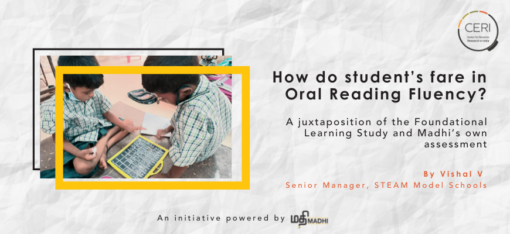
How do student’s fare in Oral Reading Fluency? A juxtaposition of the Foundational Learning Study and Madhi’s own assessment
Based on multiple reports including Annual Status of Education Report (ASER, 2014, 2018), National Achievement Survey (NAS, 2021) etc., it is now widely accepted that children in India, and in Tamil Nadu, are in the midst of a learning crisis which show that a large percentage of children in India are lagging behind in Foundational Literacy and Numeracy skills. In a crucial step towards strengthening efforts to bridge this gap, the Ministry of Education, Government of India has conducted a large-scale nationwide Foundational Learning Study (FLS) in collaboration with the National Council of Education Research and Training (NCERT, 2022). The study aims to set up benchmarks for reading with comprehension in 20 Indian languages and is one of the largest one-on-one studies with a sample size of 85000+ Grade 3 students. Parallelly, Madhi Foundation conducted a study that focuses on identifying the learning levels of children in Class 1–3 in Tamil, English, and Mathematics by taking a representative sample of 3600 students from the districts of Chennai, Ariyalur, Salem, and Thoothukudi.
In this report, we will analyse Oral Reading Fluency with reading comprehension from the National Report on Benchmarking for ORF and Numeracy and compare it with Madhi’s study to understand what level students in primary classes in Tamil Nadu are currently at.
According to the FLS, it was found that around 42% of students in Tamil Nadu could only read 0–8 words correctly in Tamil in a given period of time. Only 23% met or exceeded the global minimum proficiency standard of reading at least 28 words per minute when in grade 3. The findings from Madhi’s study corroborate the FLS on foundational literacy in Tamil. We found that the average number of words/phrases that a child in Class 3 could read was 9 words per minute with a maximum of 15 words across the sample data set. This is indeed a grave situation. However, the FLS study on English presents a slightly different picture. It studies almost all the states in India where there is English medium education and provides a national picture of foundational literacy, as compared to disaggregated state-based data. The FLS found that around 55% of students meet global proficiency standards of 35–53 correctly read words per minute. However, it is important to note that this is an India-wide average which could have severe variations across states. According to the study conducted by Madhi, a class 3 student read anywhere between 3 to a maximum of 15 words per minute in English.
In numeracy, the numbers are equally stark. According to the National Report, around 29% of all students in class 3 did not even partially meet global minimum proficiency standards. Only 20% of students even met the global minimum proficiency standard in numeracy.
Despite the rather bleak picture, it is indeed a positive sign that such benchmark studies are being conducted, which gives policymakers better data and insight from which they can design and implement interventions. Such benchmarking studies provide stakeholders with essential data to identify critical areas for improvement and develop appropriate action plans, which are often contextual as well. For example, in the Madhi conducted study, we found that the medium of instruction had an impact on the performance of students in many of the tested skills.
While this study focuses on benchmarking results and standards, it would be very useful to set up process benchmarks as well. These studies can be used to assess performance objectively while also providing contextual insights; expose areas where improvement is needed in Foundational Literacy and Numeracy; identify other states/countries with processes resulting in superior performance, with a view to their adoption; and most importantly, test whether improvement programmes have been successful and cost-effective.
Reference
Annual Status of Education Report (2014),
014mainreport_1.pdf
Annual Status of Education Report (2018),
http://img.asercentre.org/docs/ASER%202018/Release%20Material/aserreport2018.pdf
National Council of Educational Research and Training (NCERT) (2022), Foundational Learning Study, National report on benchmarking for oral reading fluency with reading comprehension and numeracy,
https://ncert.nic.in/pdf/FLS/fls_orf/ORF.pdf
Ministry of Education, National Achievement Survey (2021),
https://nas.gov.in/report-card/2021
This article was written under the aegis of the Centre for Education Research in India (CERI). CERI, an initiative powered by Madhi Foundation, is a digital repository and think-tank catering to policymakers, practitioners, and academics in the education sector and the larger community, to catalyse reform in the education ecosystem in India.
em {font-style: italic; font-size: 16px;}
